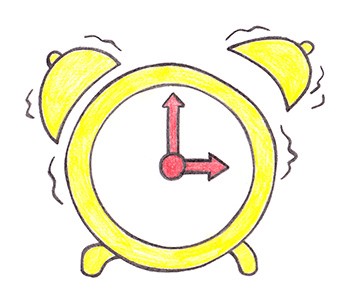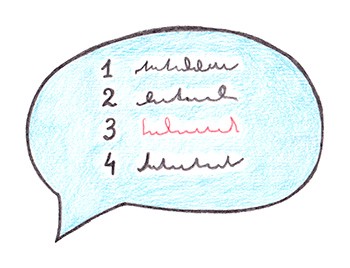Contractors: how to work with them
Some tips for those who delegate tasks, working with contractors, freelancers and other performers
Hey. I’m Sasha and I lead the studio Flyphant , which is developing mobile applications, websites and video editing and animation (in English it would sound like Motion graphics).
I often have to interact with contractors in the fields of design, copyright, working with sound, layout, programming and other related disciplines. In this regard, I have already gained a little experience, which allows me to achieve the expected result on time.
Below are a few rules that I try (not always work, but I try) to adhere to when working with contractors, as a result of which everyone is happy with the work (and the process, and the result).
Once, without even having worked, I got this review :
Olga: I did not manage to work in this company, but I talked with its representatives. I can’t say anything about how the company works, but the representatives are very nice and polite. They answer in full detail even those with whom they already will probably not work for a variety of reasons. It seems to me that the company is very loyal and with a pleasant atmosphere.
So:

1. Never delay payment
Oddly enough (although it’s strange here, we live in such a country, with such people), there are still cases where payment to contractors is delayed. And often for the reason they put “We are still waiting for payment from the client” (or from the investor, or some other regular payment).
You (yes, it is you) set the task for the contractor, agreed on a price, on payment methods. Do not blame your inability to pay on time (or even pay) to someone else. This does not bother anyone and does not solve the problem. We agreed precisely with you.
Do not assume payment obligations if you cannot fulfill them no matter what financial difficulties you will have. Book this money in advance and don’t touch it.
If the prepayment and payment at the end of the work will always be on time, then they will be more willing to work with you, because they will be confident in you.
And do not assume that the poor illustrator (designer, copywriter, etc.) is sitting and waiting only for you. Someone else will contact him and pay immediately. All. Have to look for a new artist.

2. Be sure to forward all comments in advance
The sooner you pass all the comments to the performer, the less problems you may have in further work.
Suppose you are a client project manager. On Friday night, your CEO finally spoke out about the script for the video clip (gave his comments). Now they need to be digested, translated into an understandable language and transferred to the copywriter. But it seems to be Friday, and evening, and make them short (an hour or two). You can leave it until Monday morning - you think. Tell the director that on Monday it will be ready and leave for the night break.
Morning. Monday. It's time to send comments. But the copywriter is not responding. He is simply inaccessible, he has his own affairs and in general he is not up to you at the moment.
But if you sent all the comments on Friday night, then the copywriter would have already asked you all the questions (freelancers are free people, when he wants, then he works, maybe on the weekend) and you would explain everything to him. And on Monday (although it could be at the weekend), the result would be ready, which can be shown to the director.
Do not put off until Monday what can be done on Friday.

3. Specify the time and budget, not ask
Often the timing and cost are asked from the contractor. What if he does it faster? What if it’s cheaper? Here you can save time and money. I also used to use this approach.
This led to a long selection of the contractor, adjustment of the timing of the entire project to a time convenient for him (which eventually shifts anyway), often simply to overpay, because the contractor would agree to a smaller amount, but if they ask, why not ask more. In general, all this leads to a lack of control.
But, as practice has shown, they agree to work more willingly when both the cost and the term are known. Often this happens and more profitable.
Probably, they agree more to such work, because they know that this project will not last for a long time and the money will correspond to the time spent on the work.
This is again a feeling of control over the situation, only on both sides: on the part of the customer (yours) and on the part of the contractor.

4. Lay more time than agreed
No one can predict that everything will go smoothly in the project. There are times when it turns out that the sent archive with the video source is not the source, but a sequence of frames from this video clip. This is the time to re-source in a different format. Or when they send the application source codes, and it turns out that they are all in Illustrator format, and the developers only understand Photoshop. This is the time to adapt the source. Or someone gets sick, grandmother dies, the passport is lost ... It’s terrible what is happening in the world.
Lay more time to work with the contractor than agreed with him. The longer the negotiated time, the greater should be the backup.
For example, if the contractor promised to send the work the next day, then consider that the work will be in 2 days. If you discussed with the designer that all work should be completed in 7 days, then in the internal timing you need to add another 3 days. There is no exact formula, but I usually add from 1 to 10 days.
On the other hand, if you have specified in your internal timing 10 days to work with a contractor, then you should agree with the contractor for 5-7 days already.

5. Trust
If you turned to someone for work, then you turned to this person, team, company precisely because you yourself do not know how to do this. This fact will have to be accepted, otherwise there will be plenty of people dissatisfied with the work on both sides, and this will certainly affect the result.
Take website development as an example. You, the owner of an online store, apply for its design. Turn to a professional team that knows their job. And you have the primary goal - increasing sales. Everything, absolutely everything further in this project should be subordinated to this very goal: both the structure of the site, and the arrangement of elements on the page, and the colors of the buttons.
But then you, as a client, tell the contractor that the gradient on that button needs to be done like on a glass button. You may well have the right to do so; you may well think that this will increase sales. But in this case, why did you contact this company? This is her work, her knowledge, her responsibility. The guys from this company know how to make the design so that sales increase. After all, you turned to them for this, for this knowledge?
Why trust? Firstly, these guys have been engaged in online stores for several years and have been doing them successfully (which is exactly why you turned to them?). Secondly, no matter how you like, your view of your website is far from unbiased. And these guys have a fresh look. It is much easier for them to put themselves in the place of new customers of your online store than you.
A banal example: you know how teeth should look, but you don’t tell the dentist how to work?
Trust. Guide, doubt, express your opinion, but do not demand. So the work will go much softer, it will be easier for both sides, the result will be better and sooner.
